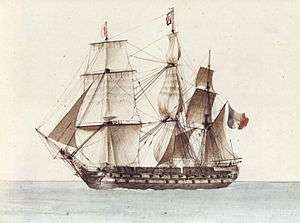French ship Génois (1805)
Génois was a Téméraire class 74-gun ship of the line of the French Navy, of the sub-type of Borée and Pluton.
 Portrait of Borée, sister-ship of Génois, on 12 April 1807, by Antoine Roux | |
| History | |
|---|---|
| Name: | Génois |
| Namesake: | Genoa (demonym) |
| Ordered: | 8 July 1803 [1] |
| Builder: | Muzzio and Migone, Genoa [1] |
| Launched: | 16 August 1805.[1] |
| Commissioned: | 1 November 1805 [1] |
| Stricken: | 1821 [1] |
| Fate: | Broken up in 1821 [1] |
| General characteristics [2] | |
| Class and type: | Téméraire-class ship of the line |
| Displacement: | |
| Length: | 54 m (177 ft 2 in) [1] |
| Beam: | 14.3 m (46 ft 11 in) [1] |
| Draught: | 6.7 m (22 ft 0 in) [1] |
| Propulsion: | Up to 2,485 m2 (26,750 sq ft) of sails [1] |
| Complement: | 678 men [1] |
| Armament: |
|
Design and construction
Designed based on plans by Jacques-Noël Sané, and updated by Maillot, she was the prototype of a new variant of the Téméraire class designed to have a smaller draught, allowing the production of ships of the line in the shallower harbours. Borée was built is Antwerp, and Génois in Genoa.[1]
Construction of Génois was awarded to the shipbuilding company Muzzio and Migone, who botched the launch on 6 August 1805: the ship stopped dead on her launching berth, and her keel hogged.[1] Engineer Forfait was sent to Genoa to save the ship, and managed to launch her properly on 16 August.[3]
Career
Génois was commissioned under Captain Lhermite on 2 November 1805.[1][4] She remained in Genoa un 1806,[5] before sailing to Toulon and taking part in the Mediterranean squadron under Vice-Admiral Ganteaume.[6] In early 1808, she sailed from Toulon to Taranto,[7] and took part in expeditions to supply Corfu.[8]
In the spring of 1809, Lhermite was replaced by Captain Montalan,[9] who took command in April, and retain it until Génois was disarmed on 23 June 1814.[10]
In March 1821, under Captain Bénard-Fleury, she ferried food supplies from Toulon to Rochefort.[11]
She was struck and broken up in 1821 in Toulon.[1]
Notes and references
References
- Roche, p.223
- Clouet, Alain (2007). "La marine de Napoléon III : classe Téméraire - caractéristiques". dossiersmarine.free.fr (in French). Archived from the original on 23 March 2013. Retrieved 4 April 2013.
- Levot, p.192
- Fonds Marine, p.324
- Fonds Marine, p.348
- Fonds Marine, p.359
- Fonds Marine, p.373
- Levot, p.315
- Fonds Marine, p.398
- Quintin, p.286
- Fonds Marine, p.542
Bibliography
- Levot, Prosper (1866). Les gloires maritimes de la France: notices biographiques sur les plus célèbres marins (in French). Bertrand.
- Quintin, Danielle; Quintin, Bernard (2003). Dictionnaire des capitaines de Vaisseau de Napoléon (in French). S.P.M. ISBN 2-901952-42-9.
- Roche, Jean-Michel (2005). Dictionnaire des bâtiments de la flotte de guerre française de Colbert à nos jours. 1. Group Retozel-Maury Millau. ISBN 978-2-9525917-0-6. OCLC 165892922.
- Fonds Marine. Campagnes (opérations ; divisions et stations navales ; missions diverses). Inventaire de la sous-série Marine BB4. Tome deuxième : BB4 1 à 482 (1790-1826)